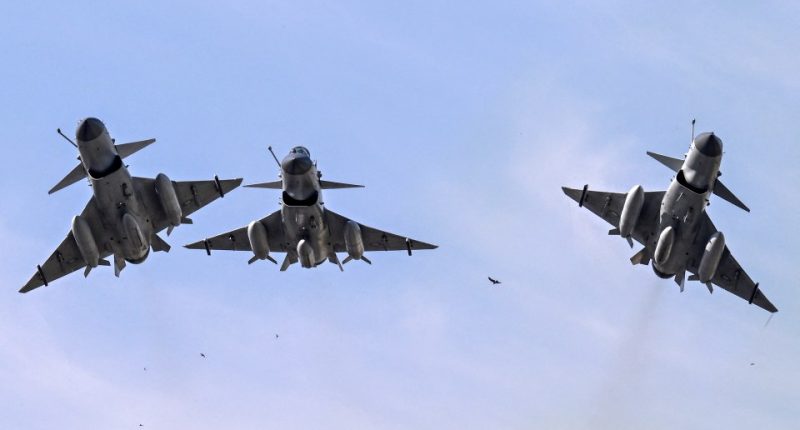Share this @internewscast.com
MORE than 100 Indian and Pakistani fighter jets reportedly clashed in a ferocious dogfight, marking one of the biggest aerial battles since World War Two.
The hour-long showdown in the skies on Wednesday saw advanced Chinese and Western weapons go head-to-head for the first time.
The high-stakes engagement reportedly involved a staggering 125 warplanes as both sides hurled long-range missiles at each other from within their own airspace, according to CNN.
Pakistani officials claimed five Indian jets were shot down using Chinese-made PL-15 missiles — though New Delhi has yet to confirm any losses.
Salman Ali Bettani, an international relations scholar at Quaid-i-Azam University in Islamabad, told CNN: “(It) is now being characterized as the most intense air-to-air combat engagement between two nuclear-armed nations.”
“The engagement represented a milestone in the operational use of advanced Chinese-origin systems.”
If verified, the battle would eclipse any air combat seen in decades and lay bare the raw military might of the nuclear-armed neighbours— both now armed with some of the most advanced aircraft in the world.
Pakistan reportedly deployed its Chinese-built J-10C jets, boasting that they had downed Indian Rafale fighters, while Indian pilots made repeated passes at targets.
Neither side crossed the border, apparently wary of triggering a repeat of the 2019 incident where an Indian pilot was captured and paraded on Pakistani TV.
But the fight is only part of a spiralling conflict between the two nations following a massacre in the Indian resort town of Pahalgam, where 26 civilians were gunned down last month.
India blames Pakistan for the attack — a charge Islamabad denies.
In response, India launched “Operation Sindoor” on Wednesday, blitzing nine targets across Pakistan and Pakistani-controlled Kashmir.
Among them was the headquarters of terrorist group Jaish-e-Mohammed (JeM), where India claims to have killed Abdul Rauf Azhar— a top JeM commander and the man linked to the beheading of Wall Street Journal reporter Daniel Pearl in 2002.
“India has killed the brutal terrorist assassin Abdul Rauf Azhar, whose psychopathic beheading of Wall Street Journal journalist Daniel Pearl in 2002 we all remember,” said former US special envoy Zalmay Khalilzad.
“Justice has been served.”
Pakistan has yet to confirm his death.
Meanwhile, India accused Pakistan of using civilian planes as “shields” during its air assault.
Wing Commander Vyomika Singh said: “Pakistan launched an unprovoked aerial assault, targeting Indian territory with drones and missiles.
“But Pakistan did not close its civilian airspace, so that commercial flights would become shields against any counterstrike.”
Indian officials also say they “repulsed” a wave of Pakistani drone attacks overnight, and blasts were reported in Jammu as air raid sirens blared in several cities.
Pakistan’s army claims up to 50 Indian soldiers have been killed in response.
Why are India and Pakistan enemies?

DISPUTES between India and Pakistan over the region of Kashmir date back decades.
The Muslim-majority territory was fought over in the aftermath of both countries’ independence following the partition of India in 1947.
War between India and Pakistan would break out again in 1965 – which ended in a ceasefire.
Kashmir’s control remains divided to this day, and tensions frequently flare up over the region.
India also fought Pakistan wars in 1971 and 1999 – with the conflict in the 70s resulting the independence of Bangladesh from Pakistan.
And the current conflict stems from how the region was split up as the two countries were gaining independence.
Indian troops took two-thirds of Kashmir, while Pakistan seized the northern third.
Since then, the row has developed into one of the most intense geopolitical rivalries on earth.
There are about 16 million people in Kashmir, split between the Indian-controlled and Pakistani-controlled zones.
Pakistan’s Prime Minister Shehbaz Sharif has vowed revenge, saying: “I promise that we will take revenge for every drop of blood of these victims.”
The Pakistani Defence Minister also issued a chilling nuclear warning:
“If they aggravate this then if a chance of war arises in which there is a sign of nuclear option being used on both sides, then the responsibility for that will be on India.”
India struck back diplomatically, branding Pakistan the “epicentre of global terrorism.”
Foreign Secretary Vikram Misri said: “I don’t need to remind the audience where bin Laden was found.”
The aerial battle has sparked alarm across the globe.
US President Donald Trump said he is prepared to do “anything to help,” while UK Prime Minister Sir Keir Starmer urged “urgent dialogue” to avoid catastrophe.
“This isn’t just a bilateral clash anymore; it’s a glimpse of how Chinese defense exports are reshaping regional deterrence,” said Craig Singleton of the US-based Foundation for Defense of Democracies.
Chinese defence stocks have surged since the battle, with shares in AVIC Chengdu Aircraft—maker of the J-10C—up 40% this week.
Beijing, which supplies the bulk of Pakistan’s weapons, has so far stayed quiet, saying only that it is “not familiar with the situation.”
Colonel Philip Ingram, a former British Army commander, previously told The Sun: “Western intelligence in particular will be focused on the readiness and the outloading of nuclear stocks inside both Pakistan and India and monitoring what’s happening to them very closely indeed.”
The dogfight is now being compared to the most historic air battles in military history — drawing parallels with the Battle of Britain, the Battle of Kursk, and the 1973 Battle of El Mansoura.
But with both sides boasting nuclear stockpiles — estimated at around 170 warheads each — the stakes today are infinitely higher.
The International Campaign to Abolish Nuclear Weapons said it is “gravely concerned” by the escalation.
Experts warn that if nuclear war erupts, it could kill as many as 125 million people.
How nuclear war could kill 125 million?

By James Halpin, Foreign News Reporter
INDIA and Pakistan are being urged to step back from armageddon as a nuclear war between the two rivals could kill 125million people.
The fighting neighbours traded rocket and artillery attacks in an overnight blitz leaving dozens dead and fears of all-out conflict.
Now, fears are abound that fighting could escalate to the use of nuclear weapons and kill tens of millions.
Peace campaigners like the International Campaign to Abolish Nuclear Weapons are “gravely concerned” and have called for the two sides to step back from the brink.
And Colonel Philip Ingram, a former British Army commander, said the West will be particularly nervous about a nuclear conflict.
Ingram told The Sun: “Western intelligence in particular will be focused on the readiness and the outloading of nuclear stocks inside both Pakistan and India and monitoring what’s happening to them very closely indeed.
“The worrying thing about these two nations is that the tensions are very real.
“The nuclear weapons are not there to protect them against attack from China or Russia or anyone else. It’s focused purely on each other.”
Ingram said escalation to using nuclear weapons could happen rapidly and powers like the US would step in to try and prevent their use.
He said: “The US Secretary of State, flying into India and Pakistan, would carry out shuttle diplomacy between the two.”
But that might not be enough to overcome the animosity between the two enemies and their desire to escalate the conflict.
Xiaodon Liang, a Senior Policy Analyst, Nuclear Weapons Policy and Disarmament, at Arms Control Association also said the primary concern should be the possibility of a battlefield use escalating to “strategic nuclear exchanges”.
Liang said: “Pakistan has made very clear that it will use nuclear weapons to prevent a full-scale Indian invasion of its territory, and the potential for uncontrollable escalation is part of what makes every crisis between India and Pakistan particularly dangerous.”




























